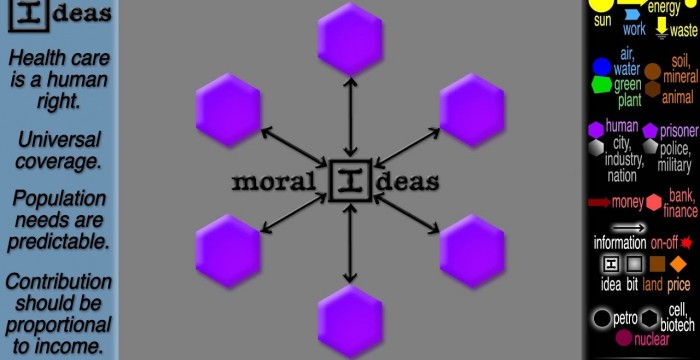VOICE NARRATOR: Let’s use these symbols to stand for all the individual people in a nation. This is a generic flag but we could use any real national flag. A nation has lots of people, millions of people — so this is just an abbreviation for them, as individuals.
The best way to pay for healthcare is by using a single-payer system. In the United States this is being called Medicare for All. It is a central pool to take all the money in (red is for money) and pay it out again to whomever needs it. Actually the money is paid out to the doctor or hospital that provides the medical care, and this can be a private business. The premiums or taxes can be less than the cost of the health care because not everyone will need it. This works a little like other kinds of insurance but there are some big differences. That is because our common moral ideas are very different. The first idea is that
HEALTHCARE IS A HUMAN RIGHT. No one chooses to be in need of medical care. It is not like choosing to “climb up the ladder” to buy a more expensive car or a bigger house. No one chooses to be ill, or to have a bad accident. No one chooses to have a pre-existing condition. No one chooses to be in need of medical care. This means that the next idea is
UNIVERSAL COVERAGE. All necessary healthcare should be covered. Everyone should be covered regardless of the ability to pay. You should be able to walk in anywhere and get the same medical treatment as anyone else. And we can do this for everyone, because
POPULATION NEEDS ARE PREDICTABLE. This means that universal health care does not need unlimited spending. Why? Because first, statistics predicts the number of diseases and accidents over time. So we know what is likely to happen overall. And the second reason is because,the treatment ends when you are well again. You personally do not want more healthcare than is necessary to be well. You just want to get well, and to get out of there! So there is a natural limit to healthcare. Again, this is opposite of cars or houses, where many people always want more. Economists would say that the “consumer demand for basic health care is finite”. In other words, it is not infinite. And this means that we can afford to cover everyone. The final idea is that
CONTRIBUTION SHOULD BE PROPORTIONAL TO INCOME. In other words, everyone must contribute, depending upon what they can afford. No one knows what health care they will need, or when they will need it, or how much it is going to cost. You might be so unfortunate that something happens that costs a lot of money. So everybody should pay in, like general taxes. The only way to be fair about it is to make the contribution a percentage of income so the richer people pay more and the poorer pay less, just like an income tax.
Single payer systems are less expensive, overall, than private insurance systems. Here, people pay larger or smaller amounts too. (These are called premiums, and a single payer may use taxes.) But in a private system this pays for better or worse medical coverage. There is no universal coverage for everyone. If a person can’t afford it, they just lose coverage. Then, if there is a problem, they must go to the emergency room — and so somebody else pays, usually the taxpayers, for a last-minute tragic situation that is also often more expensive. And: Everyone who can afford the insurance, is paying more than they need to pay. Why? One of the reasons is because after paying for the healthcare, private insurers keep about 20% to spend on administration, marketing and profits. This is almost eliminated by a single payer.
So, let’s say you have a choice: which system would you choose? Politicians in the United States try to scare people about a single-payer system, by saying it will add to your taxes. What they don’t tell you, is that you will save 15-20% overall, because you will not be paying the private premiums, which add up to more. And you will never have to worry about losing coverage. And you will never have to look at another medical bill again.
https://www.youtube.com/watch?v=PmaFAVbJzvA






